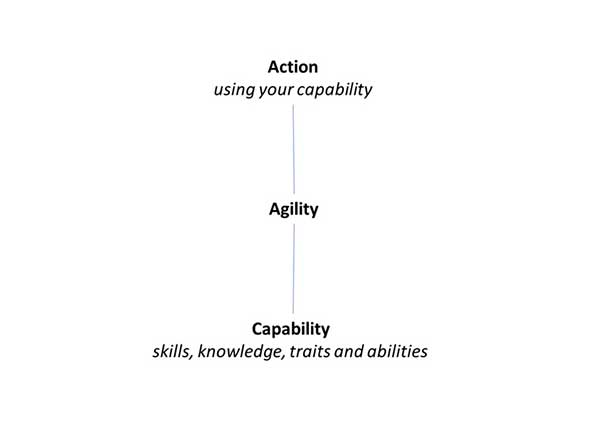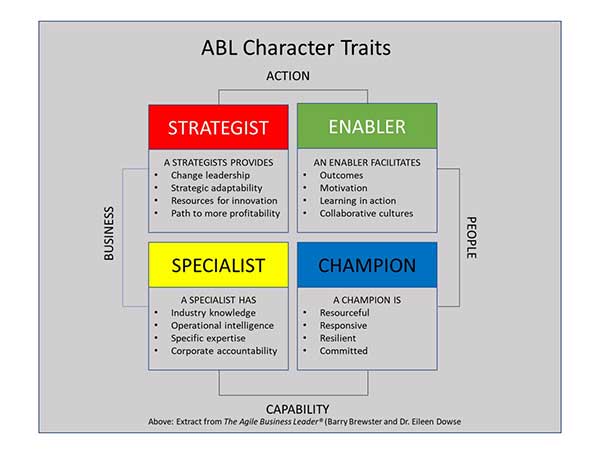Empowering Individuals and Organizations to Excel in Growth While Delivering Sustainable, Accountable, and Excellent Work
Using a model researched and developed by Human Dynamics Inc., entitled The Agile Business Leader (ABL) Leadership Development Program, this session is designed to provide leaders with a primer on practices and tools for functioning in a world of complexity, chaos, interdependency, and ambiguity. This leadership development program creates strategies for success by leveraging existing strengths, recognizing the causes and effects of peak learning, and developing strategies for mental blocks, blind spots, and other barriers.
The Agile Business Leader (ABL) Model
The ABL Model has its underpinnings in the idea of social and emotional intelligence, since it involves an ability to manage oneself in the context of interpersonal relations. In other words, to be an effective leader, one must be able to perform a task with an appropriate level of interpersonal skills, professional knowledge, and operational ability to achieve the goal. These ABL components can be driven from both internal and external sources. The model emphasizes self-awareness, engagement techniques, knowledge, and methods for business development. The ABL model is deceptively simple. It answers the question, “What type of leadership is needed in the current world of chaotic and ever-changing business practices?” The ABL model was developed from working with clients from around the world. As we listened to clients share about their issues, we consistently heard they regularly faced two realities:
- The need to be business AND people focused, and
- The need for leadership capabilities AND the ability to put turn those capabilities into action for successful outcomes.
The Horizontal Reality
The horizontal reality of the Business (financial capital: wealth employed for the production of more wealth) and the People (human capital: the sum total of an organization’s human performance capability) addresses the factors impacting the success of an organization.
Business includes: assets, liabilities, and equity. Business Capital is the net worth of a business or, in simpler terms, the amount by which the organization’s assets exceed its liabilities. Business includes the mission, goals, values, and vision for the organization. It includes the methods and practices an organization endorses to achieve financial well-being.
People includes: the human resources contributing to organizational performance. An organization’s human capital is the collective sum of the attributes, life experiences, knowledge, inventiveness, and enthusiasm of its people. It incorporates group dynamics, values, norms, attitudes, motivational forces, and collaboration that drives and influences strategic operations, employee loyalty, and commitment.
The Vertical Reality
The vertical reality of Capabilities (an individual’s unique knowledge, skills, and abilities) and Action (turning talent into effective responses) addresses the components of character and behavior.
Capability includes: the sum of the individual’s knowledge, skills, and attributes. Capability focuses on the uniqueness of the individual and his or her expertise, natural aptitude, acquired proficiency, and ability to perform. It incorporates consistent behavior and a degree of mental capacity and moral quality.
Action includes: the ability to transform knowledge and talents and convert it into strategic initiates, improved effectiveness, implementation of new business directions, or motivating people to achieve results. Action involves sensing changes in signals from the environment (both internal and external) and adapting accordingly.
When these two realities of Business and People and Action and Capability are combined, four roles (each with specific traits) emerge as the basis for leading in today’s frantic world:
- Strategist
- Enabler
- Champion
- Specialist
As change in business is inevitable, the traits of the ABL provide the competencies necessary to ensure business survival and oversee the dynamic growth of an organization. All ABL traits are essential and required for leaders to quickly deal with and adapt to change.
These ABL traits can be taught, learned, monitored, and measured to assist individuals and organizations to deliver business results.
Our Approach
Our approach to this requirement is pure and simple: to equip leaders to perform with excellence. The program is designed to enable participants to do their jobs better, faster, more accurately, and more efficiently through a combination of education and learning activities.
Developing Leadership Competencies Aligned with the Organization
We know that developing leadership competencies often requires changing people’s mental models and altering their long-standing beliefs. Our sessions shift executive, middle management, and individual contributor mindsets away from hierarchical, bureaucratic, linear thinking systems and processes, and move them towards responding quickly, with resilience, and building upon the shared knowledge of the organization.




 Meaning Conference 2025 will be the INPM’s first in-person conference with a virtual option after the pandemic.
Meaning Conference 2025 will be the INPM’s first in-person conference with a virtual option after the pandemic.